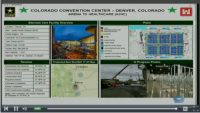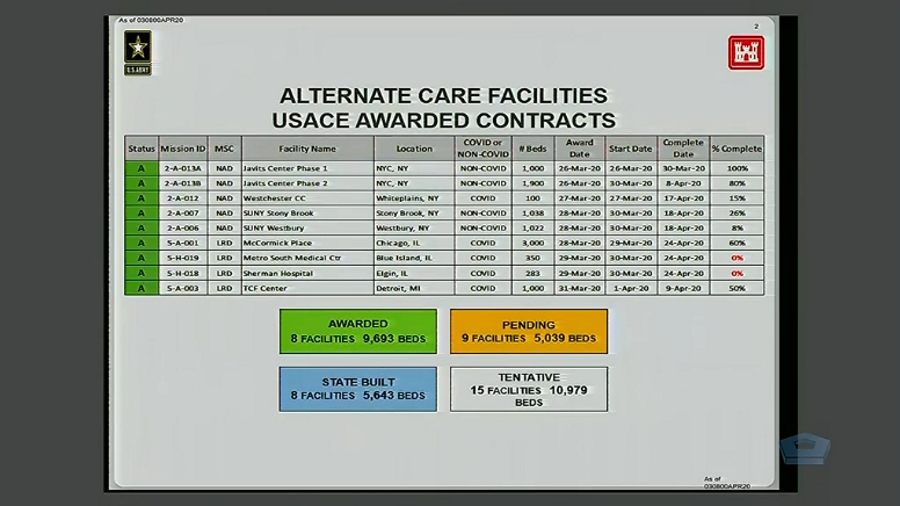COVID-19 and Construction
Army Corps Strategy Evolves Into Using Convention Center Spaces for COVID-19 Care
USACE learned from Midwest successes that large spaces could be adapted








As the U.S. Army Corps of Engineers began to convert convention centers and hotels into alternate care facilities in early April to alleviate pressure on local hospitals treating COVID-19 patients, the initial plan was to care for COVID-19 negative patients in places such as Chicago's McCormick Place, New York's Jacob K. Javits Center and Detroit's TCF Center. That strategy shifted after leaders in the USACE, the Federal Emergency Management Agency and the Department of Health and Human Services saw what USACE engineers could do with convention center spaces.
"I was not convinced we could actually change the pressure in these large convention centers to a point that would actually achieve the desired results [of care for COVID-19 positive patients] we're looking for," says Lt. Gen. Todd T. Semonite, chief of engineers and commanding general of the USACE at a Pentagon press conference April 3. "When I was in Detroit the other day with the governor [of Michigan, Gretchen Whitmer] talking to the mechanical engineers, our guys and their guys have done a phenomenal job on some relatively minor changes."
The experience on the ground at the TCF Center and Chicago's McCormick Place convinced Semonite that care for COVID-19 positive patients is an option in what the USACE and FEMA call the convention center model for alternate care facilities. Semonite said the utility of modern convention centers allowed the unexpected shift to caring for more COVID-19 patients. Engineers on the ground found that no significant mechanical changes were needed in most cases. The changes needed were as simple as a couple of technicians going into a mechanical or HVAC control room to make modifications.
"It was like turning down your thermostat in your house versus going in and replumbing an entire mechanical room," he said.
Both McCormick Place and the TCF Center are already being converted to facilities that will care for low- to moderate-risk COVID-19 patients, and both will be ready for an expected influx of patients by April 24. Semonite showed a chart of the 9,693 beds the USACE is currently preparing in eight convention centers under nine different contracts across the nation. Of those, only 2,060 are now planned to be non-COVID-19 beds. The remaining 7,633 will be for treatment and convalescence of patients with the virus. There are nine more facilities with 5,039 beds where contracts with the USACE are currently pending and 15 more facilities that are still in an earlier phase of the process. Eight more with 5,643 beds are being built by states and municipalities through their own procurement processes with design assistance from the USACE.
"Any time you have a standard design, we want to continue to learn," Semonite says. "I've been on the ground in the last couple days in New York City to Chicago and Detroit. We have continued to see where our engineers who are actually doing this construction are being pretty innovative in how we site adapt that standard design to give more capability back out to the great doctors and nurses who are going to be taking care of these patients out there."
Semonite also stressed that the eight facilities currently being repurposed by the USACE, as well as others that are being built by the states and cities through their procurement processes, are all being planned based on expected need discerned from modeling data from the coronavirus task force chaired by Vice President Mike Pence [R]. Many of those models plot the number of people getting the virus against two variables: exponential or a higher rate of growth than the national norm in a locality and the possible bed shortage in that locality.
Cause for Concern
The USACE has received 750 requests for site assessments for alternate care facilities and has completed 673 to date. Semonite said USACE leadership is in communication with Florida Gov. Ron DeSantis [R] and is looking at sites there and that the data and the demographics in Florida are a cause for concern.
"I want to reassure every community, whether a large city or a small town, if your mayor needs to have the Corps of Engineers come in to do an assessment of a site, we have the capacity to do that," Semonite said.
Every alternate care facility is being built to the specifications of the medical plan that a mayor or governor wants to use and every site is being delivered with a different contractor. In the TCF Center in Detroit, for example, Semonite said the city asked the USACE to design a manifold system that put pipes in the ceiling to deliver oxygen down into every patient pod in a particular area.
He also stressed that working with Gov. Whitmer, Ill. Governor J.B. Pritzker [D] and local officials on the ground is what helped the USACE, FEMA and HHS shift its strategy.
"Every single site we go through we learn, we wrap that back into our analysis," he said. "The convention center models, specifically Detroit and Chicago, convinced us that we are able to make that happen."








